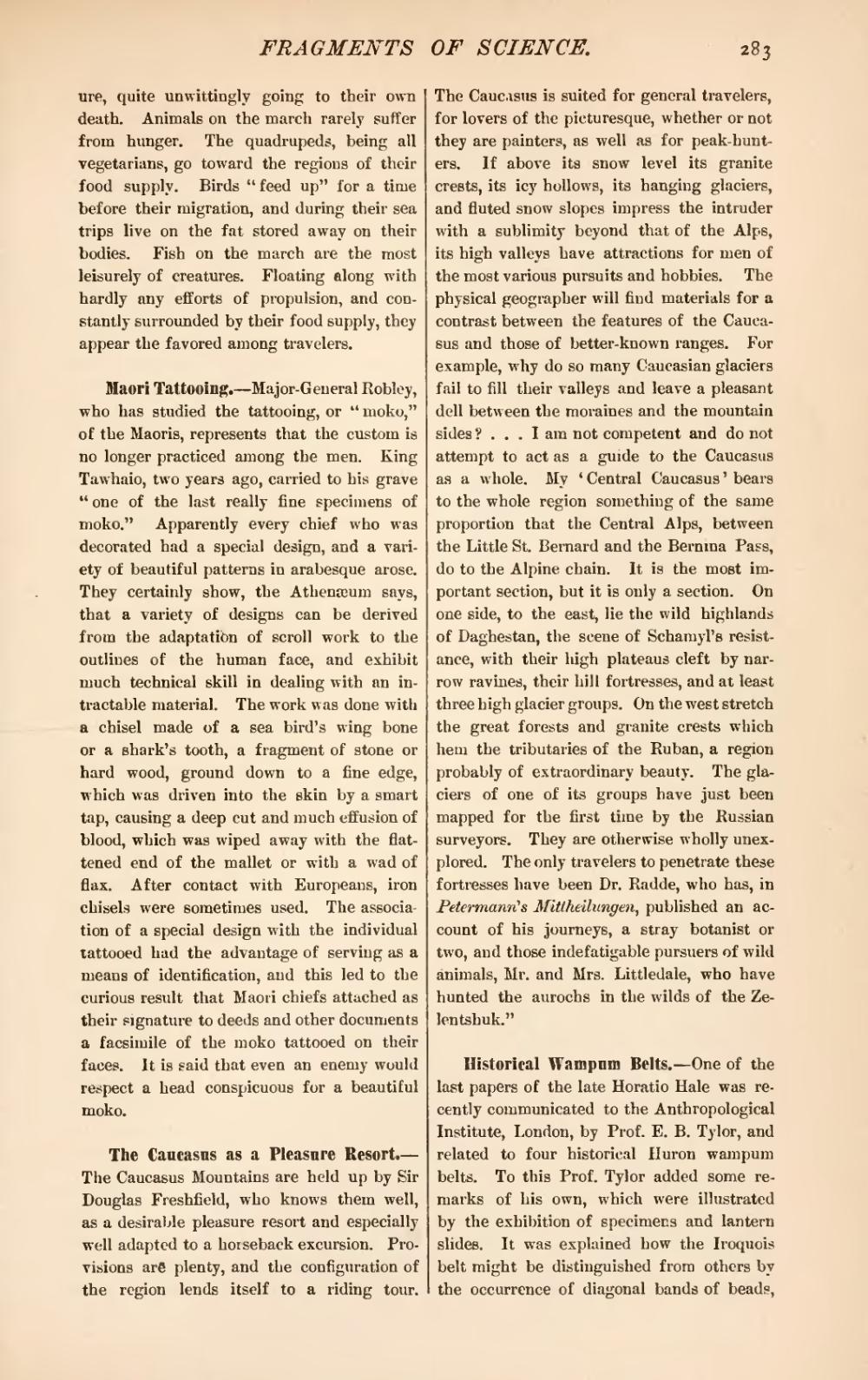ure, quite unwittingly going to their own death. Animals on the march rarely suffer from hunger. The quadrupeds, being all vegetarians, go toward the regions of their food supply. Birds "feed up" for a time before their migration, and during their sea trips live on the fat stored away on their bodies. Fish on the march are the most leisurely of creatures. Floating along with hardly any efforts of propulsion, and constantly surrounded by their food supply, they appear the favored among travelers.
Maori Tattooing.—Major-General Robley, who has studied the tattooing, or "moko," of the Maoris, represents that the custom is no longer practiced among the men. King Tawhaio, two years ago, carried to his grave "one of the last really fine specimens of moko." Apparently every chief who was decorated had a special design, and a variety of beautiful patterns in arabesque arose. They certainly show, the Athenæum says, that a variety of designs can be derived from the adaptation of scroll work to the outlines of the human face, and exhibit much technical skill in dealing with an intractable material. The work was done with a chisel made of a sea bird's wing bone or a shark's tooth, a fragment of stone or hard wood, ground down to a fine edge, which was driven into the skin by a smart tap, causing a deep cut and much effusion of blood, which was wiped away with the flattened end of the mallet or with a wad of flax. After contact with Europeans, iron chisels were sometimes used. The association of a special design with the individual tattooed had the advantage of serving as a means of identification, and this led to the curious result that Maori chiefs attached as their signature to deeds and other documents a facsimile of the moko tattooed on their faces. It is said that even an enemy would respect a head conspicuous for a beautiful moko.
The Caucasus as a Pleasure Resort.—The Caucasus Mountains are held up by Sir Douglas Freshfield, who knows them well, as a desirable pleasure resort and especially well adapted to a horseback excursion. Provisions are plenty, and the configuration of the region lends itself to a riding tour. The Caucasus is suited for general travelers, for lovers of the picturesque, whether or not they are painters, as well as for peak-hunters. If above its snow level its granite crests, its icy hollows, its hanging glaciers, and fluted snow slopes impress the intruder with a sublimity beyond that of the Alps, its high valleys have attractions for men of the most various pursuits and hobbies. The physical geographer will find materials for a contrast between the features of the Caucasus and those of better-known ranges. For example, why do so many Caucasian glaciers fail to fill their valleys and leave a pleasant dell between the moraines and the mountain sides?. . . I am not competent and do not attempt to act as a guide to the Caucasus as a whole. My 'Central Caucasus' bears to the whole region something of the same proportion that the Central Alps, between the Little St. Bernard and the Bernma Pass, do to the Alpine chain. It is the most important section, but it is only a section. On one side, to the east, lie the wild highlands of Daghestan, the scene of Schamyl's resistance, with their high plateaus cleft by narrow ravines, their hill fortresses, and at least three high glacier groups. On the west stretch the great forests and granite crests which hem the tributaries of the Ruban, a region probably of extraordinary beauty. The glaciers of one of its groups have just been mapped for the first time by the Russian surveyors. They are otherwise wholly unexplored. The only travelers to penetrate these fortresses have been Dr. Radde, who has, in Petermann's Mittheilungen, published an account of his journeys, a stray botanist or two, and those indefatigable pursuers of wild animals, Mr. and Mrs. Littledale, who have hunted the aurochs in the wilds of the Zelentshuk."
Historical Wampum Belts.—One of the last papers of the late Horatio Hale was recently communicated to the Anthropological Institute, London, by Prof. E. B. Tylor, and related to four historical Huron wampum belts. To this Prof. Tylor added some remarks of his own, which were illustrated by the exhibition of specimens and lantern slides. It was explained how the Iroquois belt might be distinguished from others by the occurrence of diagonal bands of beads,
